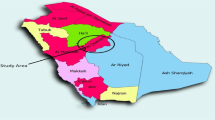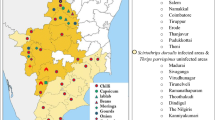Abstract
The red palm weevil (RPW), Rhynchophorus ferrugineus (Olivier), is the most deleterious pests of palms worldwide, including date palms in the Kingdom of Saudi Arabia (KSA). An understanding of RPW diversity is crucial for designing management strategies of this pest. In this study, collections of RPW from date palm plantations were made in six known RPW-infected regions of KSA. The main objectives of the study were to characterize the RPW diversity in KSA using pronotal markings and cytochrome oxidase subunit I (COI) gene. The results showed that based on pronotal markings, 18 different color morphs of RPWs were found, while based on the COI gene, it could be separated into three main haplotypes. Pronotal marking and COI gene diversity revealed that the Riyadh and Eastern Regions were the major RPW diversity hotspots and the primary sources for subsequent RPW introductions into other regions of KSA.




Similar content being viewed by others
References
Abraham VA, Al-Shuaibi M, Faleiro JR, Abozuhairah RA, Vidyasagar PSPV (1998) An integrated approach for the management of red palm weevil Rhynchophorus ferrugineus Oliv.: a key pest of date palm in the Middle East. Sultan Qaboos Univ J Sci Res Agric Sci 3:77–83
Al Dhafer HM (1997) Biological and morphological characteristics of red palm weevil Rhynchophorus ferrugineus (Olivier) ( Curculionidae: Coleoptera) in Saudi Arabia. Master Thesis plant protection department, College of Food and Agriculture Sciences, King Saud University, Saudi Arabia
Al-Ayied HY, Alswailem AM, Shair O, Jabr AMA (2006) Evaluation of phylogenetic relationship between three phenotypically different forms of red date palm weevil Rhynchophorus ferrugineus Oliv. Using PCR-based RAPD technique. Arch Phytopathol Plant Protect 39:303–309
Bezzerides AL, McGraw KJ, Parker RS, Husseini J (2007) Elytra color as a signal of chemical defense in the asian ladybird beetle Harmonia axyridis. Behav Ecol Sociobiol 61:1401–1408
Bozbuga R, Hazir A (2008) Pests of the palm (Palmae sp.) and date palm (Phoenix dactylifera) determined in Turkey and evaluation of red palm weevil (Rhynchophorus ferrugineus Olivier)(Coleoptera: Curculionidae). EPPO Bull 38:127–130
CABI (2020) Rynchophorus ferrugineus (red palm weevil). Invasive species compendium datasheet https://www.cabi.org/isc/datasheet/47472. Accessed on march 20th, 2020
Carroll SB (2000) Endless forms: the evolution of gene regulation and morphological diversity. Cell 101:577–580
Chebbi H (2011) First record of Rhynchophorus ferrugineus on Phoenix canariensis in Tunisia. Tunis J Plant Prot 6:1–6
El-Mergawy RAAM, Faure N, Nasr MI, Avand-Faghih A, Rochat D, Silvain J (2011a) Mitochondrial genetic variation and invasion history of red palm weevil, Rhynchophorus ferrugineus (Coleoptera: Curculionidae), in the middle-east and Mediterranean Basin. Int J Agric Biol 13:631–637
EPPO (2008) Data sheets on quarantine pests : Rhynchophorus ferrugineus. EPPO Bull 38:55–59
Esteban-Duran J, Yela JL, Crespo FB, Alvarez AJ (1998) Exotic curculionids liable to be introduced into Spain and other EU countries through imported vegetables. Bol San Veg Plagas 24:23–40
Folmer O, Black M, Hoeh W, Lutz R, Vrijenhoek R (1994) DNA primers for amplification of mitochondrial cytochrome c oxidase subunit I from diverse metazoan invertebrates. Mol Mar Biol Biotechnol 3:294–299
Ghosh CC (1912) Life history of indian insects-III. The Rhinoceros beetle (Oryctes rhinoceros) and the red palm weevil (Rhynchophorus ferrugineus). Entomol Ser 11:203–218
Hall TA (1999) Bioedit: a user friendly biological sequence alignment editor and analysis for windows 95/98/nt. Nucleic Acids Symp Ser 41:95–98
Hallett RH, Crespi BJ, Borden JH (2004) Synonymy of Rhynchophorus ferrugineus (Olivier), 1790 and R. vulneratus (panzer), 1798 (Coleoptera, Curculionidae, Rhynchophorinae). J Nat Hist 38:2863–2882
Hochkirch A, Deppermann J, Gröning J (2008) Phenotypic plasticity in insects: the effects of substrate color on the coloration of two ground-hopper species. Evol Dev 10:350–359
Kaakeh W, Abou-Nour MM, Khamis AA (1997) Mass rearing of red palm weevil, Rhynchophorus ferrugineus Oliv., on sugarcane and artificial diets for laboratory studies : Illustration of methodology. Faculty of Agricultural UAE:310–324
Longo S (2006) Verde urbano-ulteriori acquisizioni sul punteruolo rosso asiatico, dannoso alla palma delle canarie in Sicilia. Inf Fitopatol 10:40–44
Malumphy C, Moran H (2007) Plant pest notice: red palm weevil, Rhynchophorus ferrugineus. Department for Environment, Food and Rural Affairs, Central Science Laboratory
Melifronidou-Pantelidou A (2009) Eradication campaign for Rhynchophorus ferrugineus in Cyprus. EPPO Bull 39:155–160
Mizzi S, Dandria D, Mifsud D, Longo S (2009) The red palm weevil, Rhynchophorus ferrugineus (Olivier, 1790) in Malta (Coleoptera: Curculionoidea). Bull Entomol Soc Malta 2:111–121
MOA (2014) The current distribution of red palm weevil in the Kingdom of Saudi Arabia. Ministry of Agriculture, Riyadh
Murphy ST, Briscoe BR (1999) The red palm weevil as an alien invasive: biology and the prospects for biological control as acomponent of IPM. Biocontrol News Inf 20:35–46
Pelikh K (2009) First report of RPW in Republic of Georgia. Red Palm Weevil Website: http://www.redpalmweevil.com/. Accessed on May 21st, 2011
Rugman-Jones PF, Hoddle CD, Hoddle MS, Stouthamer R (2013) The lesser of two weevils: molecular-genetics of pest palm weevil populations confirm Rhynchophorus vulneratus (panzer 1798) as a valid species distinct from R. ferrugineus (Olivier 1790), and reveal the global extent of both. PLoS One 8:e78379
Sadder MT, Vidyasagar PS, Aldosari SA, Abdel-Azim MM, Al-Doss AA (2015) Phylogeny of red palm weevil (Rhynchophorus ferrugineus) based on ITS1 and ITS2. Orient Insects 49:1–14
Soroker V, Blumberg D, Haberman A, Hamburger-Rishard M, Reneh S, Talebaev S, Anshelevich L, Harari AR (2005) Current status of red palm weevil infestation in date palm plantations in Israel. Phytoparasitica 33:97–106
Sukirno S, Tufail M, Rasool KG, Aldawood AS (2018a) Palm weevil diversity in Indonesia: description of phenotypic variability in Asiatic palm weevil, Rhynchophorus vulneratus (Coleoptera: Curculionidae). J Entomol Res Soc 20:1–22
Sukirno S, Tufail M, Rasool KG, Aldawood AS (2018b) Undescribed color polymorphism of the Asiatic palm weevil, Rhynchophorus vulneratus panzer (Coleoptera: Curculionidae) in Indonesia: biodiversity study based on COI gene. Fla Entomol 101:642–648
Sword GA, Simpson SJ, El Hadi OTM, Wilps H (2000) Density–dependent aposematism in the desert locust. Proc R Soc Lond B Biol Sci 267:63–68
Tambe JT, Riolo P, Okolle JN, Isidoro N, Fanciulli PP, Dallai R (2013) Sexual size differences and colour polymorphism of Rhynchophorus phoenicis in the southwest region of Cameroon. Bull Insectol 66:153–159
Tamura K, Stecher G, Peterson D, Filipski A, Kumar S (2013) Mega6: molecular evolutionary genetic analysis version 6.0. Mol Biol Evol 30:2725–2729
Théry M, Pincebourde S, Feer F (2008) Dusk light environment optimizes visual perception of conspecifics in a crepuscular horned beetle. Behav Ecol 19:627–634
Vanderplank FL (1960) The bionomics and ecology of the red tree ant, Oecophylla sp., and its relationship to the coconut bug Pseudotheraptus wayi brown (Coreidae). J Anin Ecol 29:15–33
Vershinin A (1999) Biological functions of carotenoids diversity and evolution. Biofactors 10:99–104
Wang CT, Wang XZ, Tang YY, Zhang JC, Yu SL, Xu JZ, Bao ZM (2009) A rapid and cheap protocol for preparation of pcr templates in peanut. Electron J Biotechnol 12:9–10
Wattanapongsiri A (1966) A revision of the genera Rhynchophorus and Dynamis (Coleoptera: Curculionidae). Department of Agriculture Science Bulletin, Bangkok. Thailand 1, 418 pp
Acknowledgments
The authors would like to extend their sincere appreciation to the Deanship of Scientific Research at King Saud University for its funding this Research group (No: RGP-1438-009). We thank Mr. Hani and Mr. Emad from Ministry of Agriculture Riyadh for their support for RPW collections. We thank King Saud Museum of Arthropods for providing space for studying specimens. Sri Wahyuningsih, Mr. Fuad Asnawi, and Shehzad Salman are thanked for their technical support during collections of RPW in KSA. Mr. Boris Kondratieff from Colorado State University USA is thanked for reviewing the English syntax.
Author information
Authors and Affiliations
Corresponding author
Ethics declarations
Disclosure of potential conflicts of interest
All the authors declare that no author has any commercial or associative interest that represents a conflict of interest in connection with the subject of this manuscript.
Additional information
Publisher’s note
Springer Nature remains neutral with regard to jurisdictional claims in published maps and institutional affiliations.
Rights and permissions
About this article
Cite this article
Sukirno, S., Tufail, M., Rasool, K.G. et al. Diversity of red palm weevil, Rhynchophorus ferrugineus Oliv. (Coleoptera: Curculionidae) in the Kingdom of Saudi Arabia: studies on the phenotypic and DNA barcodes. Int J Trop Insect Sci 40, 899–908 (2020). https://doi.org/10.1007/s42690-020-00148-1
Received:
Accepted:
Published:
Issue Date:
DOI: https://doi.org/10.1007/s42690-020-00148-1




